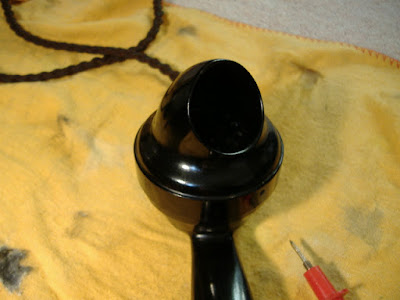Please note, a slow running rotary dial can cause problems dialling out if you are with some of the smaller telephone providers that use there own telephone exchange equipment such as TalkTalk (this is a very common problem).
To Access the Vintage Phone Dial Mechanism
1) Place a piece of sticky tape over the clear centre dial cover and pull if off quickly to safely remove the clear plastic centre dial cover.
This process is shown in the picture below:

2) Remove the paper label and then carefully unscrew the screw in the centre of the telephone dial, to remove the clear plastic (with a flat blade screwdriver).

3) Remove the small wire retaining clip from the vintage telephone dial, this is easily removed with your fingers (see the picture below)

4) Lift out the 746 telephone number plate backing out using a piece of sticky tape (as shown below).

5) The inside of the vintage dial will look very similar to the photograph below. However although the inside parts will be the same shape they may well be different colours and materials. This is because some parts of the vintage telephone dial mechanism may be plastic, others may be brass (especially in the older 1960's vintage 706 Telephones).

6) Then apply a small amount of thin "watchmaker’s oil" onto a cotton bud and use the cotton bud to clean out the dial governor cap. NEVER use WD40 as this will cause the dial to fail in a few months, its one of the worst thing you can use on these iconic vintage telephone dials.
IMPORTANT: Cleaning the telephone governor is far more important than lubricating, so make sure you are very patient and remove all the grime before lubricating.
Note: If you have access to a fully evaporating cleaning solvents (such as alcohol) clean out the telephone dial governor cap first before lubricating with watchmakers oil, again use a cotton bud for this. This extra step will ensure your vintage rotary telephone dial will remain at the correct speed for much longer than just lubricating by itself.

7) Move the cotton bud from side to side to get to the complete insides of the cup (see above and below).




8) Then replace the telephone Number dial backing (see below).

9) Replace the small wire retaining clip (see below).

10) Replace the clear plastic finger dial and centre screw and tighten the screw (see below).

11) Test that the vintage telephone dial rotates OK (to make sure the procedure has worked) and then finally replace the paper label and push fit the plastic centre cover. Then test the dial again.

All should now be OK with the vintage telephone dial. A simple repair on the UK's nostalgic 746 Telephone.
This process should work at least 70% of the time. However, if this procedure does not solve your telephone dial speed problem you may have to contact a vintage GPO telephone restorer for help or advice. Good antique telephone restorers should also have access to complex rotary telephone dial testing and speed / ratio calibration equipment.
When you buy any refurbished vintage 746 telephones most good telephone restorers should have already cleaned/lubricated and calibrated the dial so that they will work on all telephone lines, even from different providers with less forgiving telephone exchange equipment such as TalkTalk etc.
Once this task has been completed the telephone dial should give good reliable service for many years to come.






















